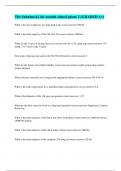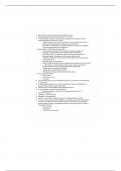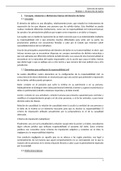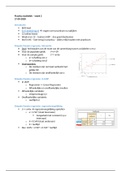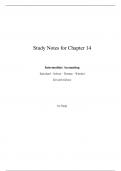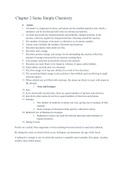Methods And Skills/ SPSS
IV: gets manipulated
DV: changes as a result
Experiments
Look for significant differences between conditions to see if manipulation influenced
participants behaviour
Decide which statistical test to use to analyse data
1. How’s the IV operationalised
Between- Participants Design: Different participants take part in diff conditions
Within- Participants Design: All participants take part in both conditions
2. How many conditions does the IV have
2 conditions – use a t-test
More than 2 condition – use ANOVA
Between- Participants Design: Independent
Within- Participants Design: Repeated- measures
Example: Independent ANOVA
ANOVA
- statistical test
- Compares mean scores from diff conditions/groups
One-way: number of IVS
, One-way repeated- measures ANOVA – Week 3
1. Open file or enter data
2. Make sure each row contains all the data from one participant
Each columns represents each condition
To tell SPSS what your IVS are
3. Click Analyse> General Linear Model> Repeated Measures
4. ‘Define Within-Subject Factor Name’ and ‘Number of Levels’
5. Click ‘Add > ‘Define’
6. Highlight factor names and move them across using the arrow
7. Click ‘Plots’> Move ‘Factor’ across using arrow to ‘Horizontal Axis’
8. Click ‘Add’> ‘Continue’
To produce means for different conditions
9. Click on ‘EM Means’
10. Move factor across
11. Select ‘Compare Main Effects’ box
Choose Post-hoc Tests
12. Click on ‘Confidence Interval Adjustment’ and select ‘Bonferroni’ click ‘Continue’
To tell SPSS what information we want to produce as part of the ANOVA
13. Click ‘Options’
14. Select ‘Descriptive Statistics’ + ‘Estimates of effect size’ click ‘Continue’
If using independent ANOVAs select ‘Homogeneity tests’
READY TO RUN – Click ‘OK’
What does it all mean?
1st box - Within-Subjects Factors
- Tells you the levels of IV and the numbers SPSS assigned to them.
2nd box – Descriptive Statistics
- Looking at ‘Mean’ column, tells us on average- the highest, and lowest scores
- To see if differences are significant need to look at inferential statistics
3rd box - Multivariate Tests
- NOT NEEDED TO INTERPRET ANOVA- SO IGNORE
,4th box – Mauchly’s Test of Sphericity
- Tests if assumption of sphericity has been met
- Tests the assumption that the r.s between different pairs of conditions is similar
- Only look at this tables if variable has more than 2 levels (more than one pair)
- You DO NOT want Mauchly’s Test of Sphericity to be significant
- To report need ‘Chi-Square’ + ‘df’ and ‘p-values/ sig.’
5th box – Tests of Within- Subjects effects
- Gives you results of ANOVA
- Tells you if effect is statistically significant
Key columns - are ‘df’ + ‘F’ + ‘sig’ + ‘Partial Eta Squared’
1. df – degrees of freedom
- represents size of the sample
- w/repeated measures need to report two of the df values
- example – one for IV one for Error
2. F – F-Ratio
- Systematic variance divided by unexpected, unsystematic variance
- The larger the F-ratio the more likely IV had significant effect on DV
- If F < 1, result will never be significant – means there’s more unexplained variance in
data than can be accounted for by IV
3. Sig. – Significance Level
- Probability your results happened by chance if null hypothesis was true
- P-value should be smaller than 0.05 – reject null hypotheses
- Reject null hypothesis- results didn’t happen by chance or because of sampling error
but are because of the IV
- If P-value larger than 0.05, must retain null hypothesis- no different between
conditions
, 4. Partial Eta Squared
- Gives you an idea of how different your samples are
- Tells you effect size
- To determine how much of an effect IV had on DV can use following cut-offs to
interpret results
0.14 or more = Large effects
0.06 or more = Medium effects
0.01 or more = Small effects
Which numbers to use?
Depends on If assumption of Sphericity has been met
- If Mauchly’s test was non-significant (assumption was met) or if you had less than 3
levels in your IV, then read ‘Sphericity Assumed’ row
- If Mauchly’s test was significant (assumption wasn’t met) then read ‘Greenhouse-
Geisser’ row
Reporting Results
To explain need to refer to Descriptive Statistics
6th box – Test of Within-Subjects Contrasts
7th box – Test of Between- Subjects Effects
DON’T NEED THEM TO INTERPRET RESULTS
8th box- Estimates- Estimated Marginal Means
- Means for different levels of IV
- for one-way ANOVA – mean values same as ‘descriptive statistics’ box
- gives you standard error rather than standard deviations
IV: gets manipulated
DV: changes as a result
Experiments
Look for significant differences between conditions to see if manipulation influenced
participants behaviour
Decide which statistical test to use to analyse data
1. How’s the IV operationalised
Between- Participants Design: Different participants take part in diff conditions
Within- Participants Design: All participants take part in both conditions
2. How many conditions does the IV have
2 conditions – use a t-test
More than 2 condition – use ANOVA
Between- Participants Design: Independent
Within- Participants Design: Repeated- measures
Example: Independent ANOVA
ANOVA
- statistical test
- Compares mean scores from diff conditions/groups
One-way: number of IVS
, One-way repeated- measures ANOVA – Week 3
1. Open file or enter data
2. Make sure each row contains all the data from one participant
Each columns represents each condition
To tell SPSS what your IVS are
3. Click Analyse> General Linear Model> Repeated Measures
4. ‘Define Within-Subject Factor Name’ and ‘Number of Levels’
5. Click ‘Add > ‘Define’
6. Highlight factor names and move them across using the arrow
7. Click ‘Plots’> Move ‘Factor’ across using arrow to ‘Horizontal Axis’
8. Click ‘Add’> ‘Continue’
To produce means for different conditions
9. Click on ‘EM Means’
10. Move factor across
11. Select ‘Compare Main Effects’ box
Choose Post-hoc Tests
12. Click on ‘Confidence Interval Adjustment’ and select ‘Bonferroni’ click ‘Continue’
To tell SPSS what information we want to produce as part of the ANOVA
13. Click ‘Options’
14. Select ‘Descriptive Statistics’ + ‘Estimates of effect size’ click ‘Continue’
If using independent ANOVAs select ‘Homogeneity tests’
READY TO RUN – Click ‘OK’
What does it all mean?
1st box - Within-Subjects Factors
- Tells you the levels of IV and the numbers SPSS assigned to them.
2nd box – Descriptive Statistics
- Looking at ‘Mean’ column, tells us on average- the highest, and lowest scores
- To see if differences are significant need to look at inferential statistics
3rd box - Multivariate Tests
- NOT NEEDED TO INTERPRET ANOVA- SO IGNORE
,4th box – Mauchly’s Test of Sphericity
- Tests if assumption of sphericity has been met
- Tests the assumption that the r.s between different pairs of conditions is similar
- Only look at this tables if variable has more than 2 levels (more than one pair)
- You DO NOT want Mauchly’s Test of Sphericity to be significant
- To report need ‘Chi-Square’ + ‘df’ and ‘p-values/ sig.’
5th box – Tests of Within- Subjects effects
- Gives you results of ANOVA
- Tells you if effect is statistically significant
Key columns - are ‘df’ + ‘F’ + ‘sig’ + ‘Partial Eta Squared’
1. df – degrees of freedom
- represents size of the sample
- w/repeated measures need to report two of the df values
- example – one for IV one for Error
2. F – F-Ratio
- Systematic variance divided by unexpected, unsystematic variance
- The larger the F-ratio the more likely IV had significant effect on DV
- If F < 1, result will never be significant – means there’s more unexplained variance in
data than can be accounted for by IV
3. Sig. – Significance Level
- Probability your results happened by chance if null hypothesis was true
- P-value should be smaller than 0.05 – reject null hypotheses
- Reject null hypothesis- results didn’t happen by chance or because of sampling error
but are because of the IV
- If P-value larger than 0.05, must retain null hypothesis- no different between
conditions
, 4. Partial Eta Squared
- Gives you an idea of how different your samples are
- Tells you effect size
- To determine how much of an effect IV had on DV can use following cut-offs to
interpret results
0.14 or more = Large effects
0.06 or more = Medium effects
0.01 or more = Small effects
Which numbers to use?
Depends on If assumption of Sphericity has been met
- If Mauchly’s test was non-significant (assumption was met) or if you had less than 3
levels in your IV, then read ‘Sphericity Assumed’ row
- If Mauchly’s test was significant (assumption wasn’t met) then read ‘Greenhouse-
Geisser’ row
Reporting Results
To explain need to refer to Descriptive Statistics
6th box – Test of Within-Subjects Contrasts
7th box – Test of Between- Subjects Effects
DON’T NEED THEM TO INTERPRET RESULTS
8th box- Estimates- Estimated Marginal Means
- Means for different levels of IV
- for one-way ANOVA – mean values same as ‘descriptive statistics’ box
- gives you standard error rather than standard deviations

